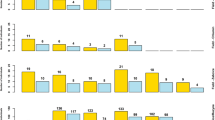Summary
Effects of random (R) or positive assortative (A) mating for pupal weight (PW) on genetic parameters of pupation time (PT), pupal and larval weights (LW) were studied in unselected populations of Tribolium castaneum. Two groups, each with 50 males mated to 100 females in each of 5 replicates, were either R-mated or A-mated for 3 generations. Genetic parameters were estimated from covariances between sibs (R group) or by an iterative method (A group). Estimates of heritability in R and A groups were 0.30±0.12 and 0.39±0.02 (PW); 0.26±0.13 and 0.49±0.04 (LW); and 0.39±0.10 and 0.25±0.03 (PT). Estimates of genetic correlations in the R group were −0.21±0.23 (PW and LW); 0.45±0.10 (PW and PT); and −0.77±0.14 (LW and PT). Those in the A group were 0.27±0.10 (PW and LW); 0.15±0.14 (PW and PT); the genetic correlation between LW and PT was not estimable in this group. Within-family variances (grams squared) of PW by generation (1, 2, and 3) were, respectively: 0.048 (R) and 0.047 (A); 0.054 (R) and 0.041 (A); and 0.050 (R) and 0.046 (A). In agreement with theory, estimates of heritability of PW and LW were larger in the A group. Estimates of genetic correlations in the A group were inconsistent with expectations from theory. Assortative mating tended to decrease within-family variance of PW.
Similar content being viewed by others
References
Bell AE (1969) The nature of selection responses in Tribolium. Jpn J Genet (Supp 1) 44:299–309
Bell AE, Burris MJ (1973) Simultaneous selection for two correlated traits in Tribolium. Genet Res 21:29–46
Bell AE, Moore CH (1972) Reciprocal recurrent selection for pupal weight in Tribolium in comparison with conventional methods. Egypt J Genet Cytol 1:92–119
Bondari K, Willham RL, Freeman AE (1978) Estimates of direct and maternal genetic correlations for pupa weight and family size of Tribolium. J Anim Sci 47:358–365
Breese EL (1956) The genetical consequences of assortative mating. Heredity 10:323–343
Bulmer MG (1980) The mathematical theory of quantitative genetics. Clarendon Press, Oxford
Crow JF, Felsenstein J (1968) The effect of assortative mating on the genetic composition of a population. Eugen Q 15:85–97
Crow JF, Kimura M (1970) An introduction to population genetics theory. Harper and Row, New York
Eaves LJ (1975) Testing models for variation in intelligence. Heredity 34:132–136
Englert DC, Bell AE (1969) Components of growth in genetically diverse populations of Tribolium castaneum. Can J Genet Cytol 11:896–907
Englert DC, Bell AE (1970) Selection for time of pupation in Tribolium castaneum. Genetics 64:541–552
Felsenstein J (1981) Continuous-genotype models and assortative mating. Theor Popul Biol 19:341–357
Fernando RL, Gianola D (1984) Rules for assortative mating in relation to selection for linear merit functions. Theor Appl Genet 68:227–237
Fisher RA (1921) On the “probable error” of a coefficient of correlation deduced from a small sample. Metron 1:3–37
Funkhouser EM, Grossman M (1982) Bias in estimation of the sampling variance of an estimate of heritability. J. Hered 73:139–141
Gianola D (1982) Assortative mating and the genetic correlation. Theor Appl Genet 62:225–231
Grossman M (1970) Sampling variance of the correlation coefficients estimated from analysis of variance and covariance. Theor Appl Genet 40:357–359
Grossman M, Norton HW (1974) Simplification of the sampling variance of the correlation coefficients. Theor Appl Genet 44:332
Howe RW (1961) Developmental time and weight in Tribolium castaneum. Tribol Inf Bull 4:21–22
King CE, Dawson PS (1972) Population biology in the Tribolium model. Evol Biol 5:133–227
Latter BDH (1965) Quantitative genetic analysis in Phalaris tuberosa. 1. The statistical theory of open pollinated progenies. Genet Res 6:51–60
Mwenya WNM (1983) Response to selection for pupal weight with and without assortative mating in Tribolium castaneum. PhD Thesis, University of Illinois
Rao AV, Narain P (1967) Genetic variance and assortative mating. J Indian Soc Agric Stat 19:32–45
Reeve ECR (1953) Studies in quantitative inheritance. 3. Heritability and genetic correlation in progeny tests using different mating systems. J Genet 51:529–542
Reeve ECR (1961) A note on nonrandom mating in progeny tests. Genet Res 2:195–203
SAS (1982) SAS User's Guide. Statistical Analysis System Institute Inc, Cary NC
Scheinberg E, Bell AE, Anderson VL (1967) Genetic gains in populations of Tribolium castaneum under uni-stage tandem selection and under restricted selection indices. Genetics 55:69–90
Searle SR (1982) Matrix algebra useful for statistics. Wiley and Sons, New York
Van Vleck LD, Hudson GFS (1982) Relationships among sires in estimating genetic variance. J Dairy Sci 65:1663–1665
Vetta A (1976) Correction to Fisher's correlations between relatives and environmental effects. Nature 263:316–317
Willham RL (1963) The covariance between relatives for characters composed of components contributed by related individuals. Biometrics 19:18–27
Yamada Y, Bell AE (1969) Selection for larval growth in Tribolium under two levels of nutrition. Genet Res 13:175–195
Author information
Authors and Affiliations
Additional information
Communicated by D. Van Vleck
Rights and permissions
About this article
Cite this article
Mwenya, W.N.M., Gianola, D. & Grossman, M. Effects of assortative mating for pupa weight on genetic parameters of unselected Tribolium castaneum . Theoret. Appl. Genetics 72, 388–394 (1986). https://doi.org/10.1007/BF00288578
Received:
Accepted:
Issue Date:
DOI: https://doi.org/10.1007/BF00288578




